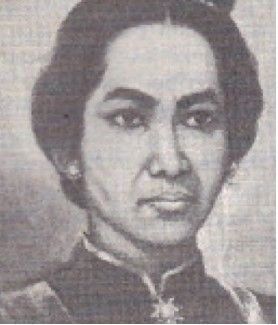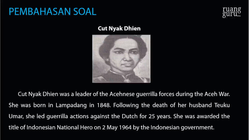Iklan
Pertanyaan
CUT NYAK DHIEN Cut Nyak Dhien was a leader of the Acehnese guerrilla forces during the Aceh War. She was born in Lampadang in 1848. Following the death of her husband Teuku Umar, she led guerrilla actions against the Dutch for 25 years. She was awarded the title of Indonesian National Hero on 2 May 1964 by the Indonesian government. Cut Nyak Dhien was born into an Islamic aristocratic family in Aceh Besar. Her father, Teuku Nanta Setia, was a member of the ruling Ulèë Balang aristocratic class in VI mukim, and her mother was also from an aristocratic family. She was educated in religion and household matters. She was renowned for her beauty, and many men proposed to marry her. Finally, she married Teuku Cik Ibrahim Lamnga, the son of an aristocratic family, when she was twelve. On 26 March 1873, the Dutch declared war on Aceh. In November 1873, during the Second Aceh Expedition, the Dutch successfully captured VI mukim in 1873, followed by the Sultan’s Palace in 1874. In 1875, Cut Nyak Dhien and her baby, along with other mothers, were evacuated to a safer location while her husband Ibrahim Lamnga fought to reclaim VI mukim. Lamnga died in action on June 29, 1878. Hearing this, Cut Nyak Dhien was enraged and swore to destroy the Dutch. Some time later, Teuku Umar proposed to marry her. Learning that Teuku Umar would allow her to fight, she accepted his proposal. They were married in 1880. This greatly boosted the morale of Aceh armies in their fight against Dutch. Teuku Umar and Cut Nyak Dhien had a daughter, Cut Gambang. The war continued, and the Acehnese declared Holy War against the Dutch, and were engaged in guerrilla warfare. Undersupplied, Teuku Umar surrendered to the Dutch forces on September 30, 1893 along with 250 of his men. The Dutch army welcomed him and appointed him as a commander, giving him the title of Teuku Umar Johan Pahlawan. However, Teuku Umar secretly planned to betray the Dutch. Two years later Teuku Umar set out to assault Aceh, but he instead deserted with his troops taking with them heavy equipment, weapons, and ammunition, using these supplies to help the Acehnese. This is recorded in Dutch history as “Het verraad van Teukoe Oemar” (the treason of Teuku Umar). The Dutch general Johannes Benedictus van Heutsz sent a spy to Aceh. Teuku Umar was killed during a battle when the Dutch launched a surprise attack on him in Meulaboh. When Cut Gambang cried over his death, Cut Nyak Dhien slapped her and then she hugged her and said: “As Acehnese women, we may not shed tears for those who have been martyred.” After her husband died, Cut Nyak Dhien continued to resist the Dutch with her small army until its destruction in 1901, as the Dutch adapted their tactics to the situation in Aceh. Furthermore, Cut Nyak Dhien suffered from nearsightedness and arthritis as she got older. The number of her troops was also decreasing and they suffered from lack of supplies. One of her troops, Pang Laot, told the Dutch the location of her headquarters in Beutong Le Sageu. The Dutch attacked, catching Dhien and her troops bysurprise. Despite desperately fighting back, Dhien was captured. Her daughter, Cut Gambang, escaped and continued the resistance. Dhien was brought to Banda Aceh and her myopia and arthritis slowly healed, but in the end she was exiled to Sumedang, West Java because the Dutch were afraid she would mobilize the resistance of Aceh people. She died on 6 November 1908. (Adapted from: http://en.wikipedia.org/wiki/Cut_Nyak_Dhien) Note: Mukim is an area consisting of 5 villages . Answer the following questionby referring to the reading text about Cut Nyak Dhien! According to the text, how should an Acehnese woman respond to the death of her family member in a war?
CUT NYAK DHIEN

Cut Nyak Dhien was a leader of the Acehnese guerrilla forces during the Aceh War. She was born in Lampadang in 1848. Following the death of her husband Teuku Umar, she led guerrilla actions against the Dutch for 25 years. She was awarded the title of Indonesian National Hero on 2 May 1964 by the Indonesian government.
Cut Nyak Dhien was born into an Islamic aristocratic family in Aceh Besar. Her father, Teuku Nanta Setia, was a member of the ruling Ulèë Balang aristocratic class in VI mukim, and her mother was also from an aristocratic family. She was educated in religion and household matters. She was renowned for her beauty, and many men proposed to marry her. Finally, she married Teuku Cik Ibrahim Lamnga, the son of an aristocratic family, when she was twelve.
On 26 March 1873, the Dutch declared war on Aceh. In November 1873, during the Second Aceh Expedition, the Dutch successfully captured VI mukim in 1873, followed by the Sultan’s Palace in 1874. In 1875, Cut Nyak Dhien and her baby, along with other mothers, were evacuated to a safer location while her husband Ibrahim Lamnga fought to reclaim VI mukim. Lamnga died in action on June 29, 1878. Hearing this, Cut Nyak Dhien was enraged and swore to destroy the Dutch.
Some time later, Teuku Umar proposed to marry her. Learning that Teuku Umar would allow her to fight, she accepted his proposal. They were married in 1880. This greatly boosted the morale of Aceh armies in their fight against Dutch. Teuku Umar and Cut Nyak Dhien had a daughter, Cut Gambang.
The war continued, and the Acehnese declared Holy War against the Dutch, and were engaged in guerrilla warfare. Undersupplied, Teuku Umar surrendered to the Dutch forces on September 30, 1893 along with 250 of his men. The Dutch army welcomed him and appointed him as a commander, giving him the title of Teuku Umar Johan Pahlawan. However, Teuku Umar secretly planned to betray the Dutch. Two years later Teuku Umar set out to assault Aceh, but he instead deserted with his troops taking with them heavy equipment, weapons, and ammunition, using these supplies to help the Acehnese. This is recorded in Dutch history as “Het verraad van Teukoe Oemar” (the treason of Teuku Umar).
The Dutch general Johannes Benedictus van Heutsz sent a spy to Aceh. Teuku Umar was killed during a battle when the Dutch launched a surprise attack on him in Meulaboh. When Cut Gambang cried over his death, Cut Nyak Dhien slapped her and then she hugged her and said: “As Acehnese women, we may not shed tears for those who have been martyred.”
After her husband died, Cut Nyak Dhien continued to resist the Dutch with her small army until its destruction in 1901, as the Dutch adapted their tactics to the situation in Aceh. Furthermore, Cut Nyak Dhien suffered from nearsightedness and arthritis as she got older. The number of her troops was also decreasing and they suffered from lack of supplies.
One of her troops, Pang Laot, told the Dutch the location of her headquarters in Beutong Le Sageu. The Dutch attacked, catching Dhien and her troops by surprise. Despite desperately fighting back, Dhien was captured. Her daughter, Cut Gambang, escaped and continued the resistance. Dhien was brought to Banda Aceh and her myopia and arthritis slowly healed, but in the end she was exiled to Sumedang, West Java because the Dutch were afraid she would mobilize the resistance of Aceh people. She died on 6 November 1908.
(Adapted from: http://en.wikipedia.org/wiki/Cut_Nyak_Dhien)
Note: Mukim is an area consisting of 5 villages.
Answer the following question by referring to the reading text about Cut Nyak Dhien!
According to the text, how should an Acehnese woman respond to the death of her family member in a war?
Iklan
A. Lee
Master Teacher
1
0.0 (0 rating)
Iklan
Pertanyaan serupa
RUANGGURU HQ
Jl. Dr. Saharjo No.161, Manggarai Selatan, Tebet, Kota Jakarta Selatan, Daerah Khusus Ibukota Jakarta 12860
Produk Ruangguru
Bantuan & Panduan
Hubungi Kami
©2026 Ruangguru. All Rights Reserved PT. Ruang Raya Indonesia

















